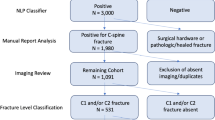Abstract
Objectives
As the population within the USA ages, the number of hip fractures seen yearly in the emergency department is expected to rise. According to the NEXUS criteria, many of these patients receive computerized tomographic scan (CT) evaluation of the cervical spine because a hip fracture may constitute a distracting injury. The objective of this study is to determine if an isolated hip fracture constitutes a distracting injury which requires imaging of the cervical spine.
Methods
Data were prospectively collected on 158 trauma patients with isolated hip fractures between April 1, 2015 and March 9, 2016. Patient demographics were analyzed and compared to the National Emergency X-Radiography Utilization Study (NEXUS).
Results
Patients with isolated hip fractures were predominantly elderly, on average 78.6 +/− 15.9 years old, and 94.3% of these injuries occurred after a fall from standing. Only one patient also had a cervical spine fracture which was not clinically significant. When compared to the established rate of cervical spine injury of 2.4%, the absolute risk reduction (ARR) was 0.35% (95% CI, − 1.06 to 1.75%) and the number needed to treat (NNT) was 290.
Conclusion
In the case of an elderly patient with an isolated hip fracture and no cervical midline tenderness, cervical spine imaging may be reserved for those who have other NEXUS criteria for further workup.
Similar content being viewed by others
References
Stevens JA, Rudd RA (2013) The impact of decreasing U.S. hip fracture rates on future hip fracture estimates. Osteoporos Int 24:2725–2728
Baker PN, Salar O, Ollivere BJ et al (2014) Evolution of the hip fracture population: time to consider the future? A retrospective observational analysis. BMJ Open 4(4):e004405. https://doi.org/10.1136/bmjopen-2013-004405
Boland LL, Satterlee PA, Jansen P (2014) Cervical spine fractures in elderly patients with hip fracture after low-level fall: an opportunity to refine prehospital spinal immobilization guidelines? Prehosp Disaster Med 29(1):96–99. https://doi.org/10.1017/S1049023X14000041
Hoffman JR, Mower WR, Wolfson AB, Todd KH, Zucker M (2000) Validity of a set of clinical criteria to rule out injury to the cervical spine in patients with blunt trauma. National Emergency X-radiography utilization study group. N Engl J Med 343(2):94–99
Hoffman JR, Wolfson AB, Todd K, Mower W (1998) Selective cervical spine radiography in blunt trauma: methodology of the National Emergency X-radiography utilization study (NEXUS). Ann Emerg Med 32(4):461–469
Chang CH, Holmes JF, Mower WRPE (2005) Distracting injuries in patients with vertebral injuries. J Emerg Med 28(2):147–152
Ullrich A, Hendey GW, Geiderman J, Shaw SG, Hoffman J, Mower W (2001) Distracting painful injuries associated with cervical spinal injuries in blunt trauma. Acad Emerg Med 8(1):25–29
Heffernan DS, Schermer CR, Lu S (2005) What defines a distracting injury in cervical spine assessment? J Trauma 59(6):1396–1399
Bouhassira D, Le Bars D, Villanueva L (1987) Heterotopic activation of A delta and C fibres triggers inhibition of trigeminal and spinal convergent neurones in the rat. J Physiol 389:301–317
Gonzalez RP, Fried PO, Bukhalo M, Holevar MR, Falimirski M (1999) Role of clinical examination in screening for blunt cervical spine injury. J Am Coll Surg 189:152–157
Velmahos GC, Theodorou D, Tatevossian R, Belzberg H, Cornwell EE 3rd, Berne TV, Asensio JADD (1996) Radiographic cervical spine evaluation in the alert asymptomatic blunt trauma victim: much ado about nothing. J Trauma 40(5):768–774
Stiell IG, Wells GA, Vandemheen KL, Clement CM, Lesiuk H, De Maio VJ, Laupacis A, Schull M, McKnight RD, Verbeek R, Brison R, Cass D, Dreyer J, Eisenhauer MA, Greenberg GH, MacPhail I, Morrison L, Reardon MWJ (2001) The Canadian C-spine rule for radiography in alert and stable trauma patients. JAMA 286(15):1841–1848
Goode T, Young A, Wilson SP, Katzen J, Wolfe LG, Duane T (2014) Evaluation of cervical spine fracture in the elderly: can we trust our physical examination? Am Surg 80(2):182–184
Morrison J, Jeanmonod R (2014) Imaging in the NEXUS-negative patient: when we break the rule. Am J Emerg Med 32(1):67–70. https://doi.org/10.1016/j.ajem.2013.08.062
Collins NC, McKenzie J (2013) The NEXUS criteria: do they stand the test of time? Eur J Emerg Med 20(1):58–60. https://doi.org/10.1097/MEJ.0b013e32834fe94a
Denver D, Shetty A, Unwin D (2015) Falls and implementation of NEXUS in the elderly (the FINE study). J Emerg Med 49(3):294–300. https://doi.org/10.1016/j.jemermed.2015.03.005
Roberge RJ, Samuels J (1999) Cervical spine injury in low-impact blunt trauma. Am J Emerg Med 17(2):125–129
Korhonen N, Kannus P, Niemi S, Parkkari J, Sievänen H (2014) Rapid increase in fall-induced cervical spine injuries among older Finnish adults between 1970 and 2011. Age Ageing 43(4):567–571. https://doi.org/10.1093/ageing/afu060
North Carolina Industrial Commission (2015) CPT Codes and Fees http://www.ic.nc.gov/ncic/pages/70000.htm Accessed 23 July 2017
Keysor K (2017) 2017 Medicare physician fee schedule Prorposed rule. https://www.ACR.Org/~/media/ACR/documents/PDF/economics/Medicare/2016%20MPFS/impact%20Table%2070000%20codes2016%20MPFS.pdf. Accessed 23 July 2017
Missouri Department of Social Services (2016) Outpatient Hospital Radiology Fee Schedule www.dss.mo.gov/mhd/providers/files/outpatient-hospital-radiology-fee-schedule.xlsx Accessed 24 July 2017
Sparrow (2017) Sparrow Patient Financial Services- Pricing https://www.sparrow.org/upload/docs/MySparrow/Radiology%20Pricing.pdf Accessed 23 July 2017
Author information
Authors and Affiliations
Corresponding author
Ethics declarations
Conflict of interest
The authors declare that they have no conflict of interest.
Rights and permissions
About this article
Cite this article
Lindborg, R., Jambhekar, A., Chan, V. et al. Distracting injury defined: does an isolated hip fracture constitute a distracting injury for clearance of the cervical spine?. Emerg Radiol 25, 35–39 (2018). https://doi.org/10.1007/s10140-017-1555-x
Received:
Accepted:
Published:
Issue Date:
DOI: https://doi.org/10.1007/s10140-017-1555-x




